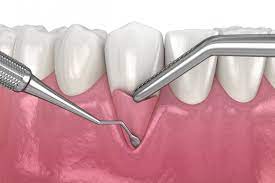Introduction
A beautiful smile can boost your confidence and leave a lasting impression. However, gum recession can mar the appearance of your smile and lead to other oral health issues. Fortunately, gum grafting is a highly effective procedure that can restore your gum line, enhance your smile, and improve your overall oral health. In this article, we will explore the fascinating world of gum grafting, from what it is and how it works to the benefits, recovery process, and alternatives. Discover the remarkable transformation of gum grafting before and after, and take the first step toward regaining your radiant smile.
What is Gum Grafting and How Does it Work?
Gum grafting is a surgical procedure that involves taking healthy gum tissue from one part of your mouth and grafting it onto areas affected by gum recession. This innovative technique not only enhances the appearance of your smile but also protects your teeth from damage caused by exposed roots. By covering the exposed roots and restoring a healthy gum line, gum grafting promotes gum regeneration and prevents further recession.
The Benefits of Gum Grafting Surgery
Gum grafting surgery offers numerous benefits, both cosmetic and functional. Here are some of the key advantages:
- Enhanced Aesthetics: Gum grafting can significantly improve the appearance of your smile by restoring a symmetrical and healthy gum line.
- Protection from Tooth Sensitivity: Exposed tooth roots due to gum recession can cause tooth sensitivity to hot, cold, or sweet stimuli. Gum grafting covers these sensitive areas, reducing discomfort and enhancing your ability to enjoy food and drinks.
- Preservation of Tooth Structure: Gum recession can lead to the loss of supporting bone and tooth structure. By addressing gum recession promptly through gum grafting, you can prevent further damage and potential tooth loss.
- Reduced Risk of Gum Disease: Receded gums create pockets where harmful bacteria can accumulate, leading to gum disease. Gum grafting eliminates these pockets and makes oral hygiene maintenance easier, reducing the risk of gum disease.
The Recovery Process After Gum Grafting
After gum grafting surgery, a proper recovery process is crucial for optimal results. Here are some important points to consider:
- Post-Operative Care: Following the surgery, your dentist or periodontist will provide detailed instructions on how to care for your gums. This may include recommendations on oral hygiene, dietary restrictions, and the use of prescribed medications.
- Healing Time: The healing process varies for each individual, but on average, it takes about 1 to 2 weeks for the gums to heal. However, complete healing may take several months.
- Managing Discomfort: Discomfort and mild pain are normal after gum grafting surgery. Your dentist may prescribe pain medication or recommend over-the-counter pain relievers to alleviate any discomfort.
- Follow-Up Appointments: Regular follow-up visits with your dentist or periodontist are essential to monitor the healing progress, remove stitches if necessary, and ensure the success of the procedure.
Different Types of Gum Grafting Techniques
Several gum grafting techniques exist, and the choice depends on the specific needs and condition of each patient. Here are three common types:
- Connective Tissue Graft: This technique involves harvesting a small amount of tissue from the roof of the mouth and grafting it onto the recipient site. It is the most commonly used method for treating gum recession.
- Free Gingival Graft: Suitable for patients with thin gum tissue, this technique involves directly grafting tissue from the roof of the mouth onto the receded area, without using an underlying connective tissue layer.
- Pedicle Graft: In this technique, the graft tissue is taken from the gum tissue near the affected area. The tissue is then partially cut and rotated to cover the exposed root, allowing it to remain connected to its blood supply.
The Success Rate and Potential Complications
Gum grafting has a high success rate and is considered a safe and reliable procedure. However, as with any surgical procedure, there are potential risks and complications. These can include infection, swelling, bleeding, allergic reactions, and temporary discomfort. It is essential to follow your dentist’s instructions carefully and promptly report any concerns during the recovery period.
Gum Grafting Cost and Insurance Coverage
The cost of gum grafting can vary depending on factors such as the extent of gum recession, the chosen grafting technique, and your location. On average, gum grafting can cost between $600 and $1,200 per tooth. Insurance coverage may vary, but in general, dental insurance plans may partially cover the cost of gum grafting if it is deemed medically necessary.
Alternatives to Gum Grafting for Treating Gum Recession
While gum grafting is a highly effective treatment for gum recession, there are alternatives available depending on the severity of the recession and the individual case. Some alternatives include:
- Pinhole Surgical Technique: This minimally invasive procedure involves making small incisions in the gums and using specialized instruments to gently reposition the gum tissue over the exposed roots.
- Guided Tissue Regeneration: This technique involves the use of membranes or tissue-stimulating proteins to encourage the growth of new gum tissue.
- Dental Restoration: In cases where gum recession is primarily caused by tooth misalignment or malocclusion, orthodontic treatment or dental restorations may be recommended to correct the underlying issue and prevent further recession.
Frequently Asked Questions
Q: How long does it take to recover from gum grafting?
A: The recovery time for gum grafting can vary, but it generally takes 1 to 2 weeks for the initial healing. Complete healing and tissue regeneration may take several months.
Q: Can gum grafting help with receding gums?
A: Yes, gum grafting is specifically designed to treat and reverse gum recession by covering exposed tooth roots and restoring a healthy gum line.
Q: What is the recommended post-operative care after gum grafting?
A: Post-operative care typically involves maintaining excellent oral hygiene, following a soft food diet, avoiding smoking and tobacco products, and taking any prescribed medications as instructed.
Conclusion
Gum grafting is a transformative procedure that can restore the health, aesthetics, and function of your gums. By addressing gum recession and restoring a healthy gum line, gum grafting enhances your smile, protects your teeth, and reduces the risk of gum disease. With various techniques available and a high success rate, gum grafting is a reliable solution for achieving a radiant smile. Consult with a qualified dental professional to determine if gum grafting is the right choice for you and take the first step toward a happier, healthier smile.

Tasha Harshman is a dynamic writer with a broad range of expertise. She creates compelling and informative content, offering valuable insights and consistently engaging readers with her deep knowledge and passion for a variety of subjects.

